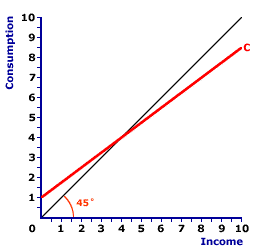
|
|
RISK AVERSE: A person who values a certain income more than an equal amount of income that involves risk or uncertainty. To illustrate, let's say that you're given two options--(A) a guaranteed $1,000 or (b) a 50-50 chance of getting either $500 or $1,500. If you chose option A, then you're risk averse. Both options give you the same "expected" values. In other words, if you select option B a few hundred times, then your average amount over those few hundred times is $1,000.
Visit the GLOSS*arama
|
|


|

|
                           CONSUMPTION LINE: A graphical depiction of the relation between household sector consumption and income that forms one of the key building blocks for Keynesian economics. A consumption line is characterized by vertical intercept, which indicates autonomous consumption, and slope, which is the marginal propensity to consume and indicates induced consumption. The aggregate expenditures line used in Keynesian economics is derived by adding or stacking investment, government purchases, and net exports to the consumption line. Saving is indicated as the difference between the consumption line and the 45-degree guide line. The consumption line, also termed propensity-to-consume line or consumption function, shows the relation between consumption expenditures and income for the household sector. The income measure commonly used is national income or disposable income. Occasionally a measure of aggregate production, such as gross domestic product, is used instead.The purpose of the consumption line is to graphically illustrate the basic consumption-income relation for the household sector, which is the foundation of the aggregate expenditures line used in Keynesian economics. Two basic types of consumption are indicated by the consumption line. Autonomous consumption is the vertical intercept, or Y-intercept, of the consumption line. Induced consumption is the slope of the consumption line. Of no small importance, the slope of the consumption line is also the marginal propensity to consume (MPC). | Consumption Line | 
|
A representative consumption line is presented in the exhibit to the right. This red line, labeled C in the exhibit is positively sloped, indicating that greater levels of income generate greater consumption expenditures by the household sector. This positive relation corresponds to the fundamental psychological law of Keynesian economics.For reference, a black 45-degree line is also presented in this exhibit. Because this line has a slope of one, it indicates the relative slope of the consumption line. The two primary characteristics of the consumption line are slope and intercept: - Slope: The slope of the consumption line presented here is positive, but less than one. In fact, the slope of the consumption line is numerically equal to the marginal propensity to consume. In this case the slope is equal to 0.75. The positive slope reflects induced consumption expenditures--more income means more consumption. It also reflects the basic Keynesian psychological law. Click the [Slope] button to illustrate.
- Intercept: The consumption line intersects the vertical axis at a value of $1 trillion. Theoretically, this is a minimum "baseline" level of consumption, the amount of consumption undertaken even if income falls to zero. More to the point, this intersection indicates autonomous consumption--consumption expenditures unrelated to income. Click the [Intercept] button to illustrate.
The other side of consumption-income relation is saving, specifically it is the difference between income and consumption. Saving can be identified by the vertical difference between the consumption line and the 45-degree line. Click the [Saving] button is illustrate this. If the 45-degree line lies above the consumption line, then saving is positive. If the 45-degree line lies below the consumption line, then saving is negative. Lastly, note that the level of income (and production) generated by full employment of resources is NOT indicated in this exhibit. Full employment could correspond with $2 trillion of income or $20 trillion. There is no way of knowing. This is particularly important when the aggregate expenditures line, used to identified equilibrium, is derived based on the consumption line.

Recommended Citation:CONSUMPTION LINE, AmosWEB Encyclonomic WEB*pedia, http://www.AmosWEB.com, AmosWEB LLC, 2000-2024. [Accessed: October 30, 2024].
Check Out These Related Terms... | | | | | | | | | | | | |
Or For A Little Background... | | | | | | | | | |
And For Further Study... | | | | | | | | | | | | | | |
Search Again?
Back to the WEB*pedia
|



|

|
YELLOW CHIPPEROON
[What's This?]
Today, you are likely to spend a great deal of time looking for a downtown retail store seeking to buy either a T-shirt commemorating yesterday or a pair of handcrafted oven mitts. Be on the lookout for defective microphones.
Your Complete Scope
This isn't me! What am I?
|

|
|
A scripophilist is one who collects rare stock and bond certificates, usually from extinct companies.
|

|
|
"Anyone who has never made a mistake has never tried anything new. " -- Albert Einstein, physicist
|

|
AEC
Annual Equivalent Costs
|

|
|
Tell us what you think about AmosWEB. Like what you see? Have suggestions for improvements? Let us know. Click the User Feedback link.
User Feedback
|


|


